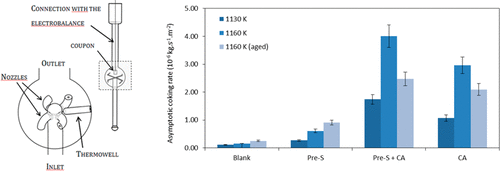当前位置:
X-MOL 学术
›
Ind. Eng. Chem. Res.
›
论文详情
Our official English website, www.x-mol.net, welcomes your
feedback! (Note: you will need to create a separate account there.)
Coking Tendency of 25Cr-35Ni Alloys: Influence of Temperature, Sulfur Addition, and Cyclic Aging
Industrial & Engineering Chemistry Research ( IF 3.8 ) Pub Date : 2018-02-27 00:00:00 , DOI: 10.1021/acs.iecr.7b04719 Natália Olahová 1 , Stamatis A. Sarris 1 , Marie-Françoise Reyniers 1 , Guy B. Marin 1 , Kevin M. Van Geem 1
Industrial & Engineering Chemistry Research ( IF 3.8 ) Pub Date : 2018-02-27 00:00:00 , DOI: 10.1021/acs.iecr.7b04719 Natália Olahová 1 , Stamatis A. Sarris 1 , Marie-Françoise Reyniers 1 , Guy B. Marin 1 , Kevin M. Van Geem 1
Affiliation

|
25Cr-35Ni base alloys are the most frequently used materials for steam cracking reactors. The influence of cyclic aging, reactor temperature, and adding sulfur containing compounds before or during cracking on the rate of coke deposition on a classical 25Cr-35Ni alloy is evaluated using a jet stirred reactor equipped with an electrobalance. As expected, the initial and asymptotic coking rate increased with increasing reactor temperature. Scanning electron microscopy coupled with energy dispersive X-ray (SEM-EDX) analysis indicated that more Ni and Fe is present on the surface at higher cracking temperatures. Presulfidation led to increased coke deposition and decreased CO yields compared to the reference. When a sulfur containing compound was added continuously, coke deposition increased significantly but carbon oxide formation was suppressed. A pronounced amount of coke was measured in the reactor, followed by suppressed generated amounts of carbon oxides downstream. When combined with the continuous addition of sulfur containing compounds, presulfidation has little effect. Depending on the conditions, the effect of aging of the material is different: during the reference run and when only presulfidation was applied, coking rates increased as the material aged. When sulfur containing compounds were added continuously, with our without presulfidation, coking rates decreased as the material aged. This can be related with increased amounts of MnCr2O4 and Cr2O3 observed by SEM and EDX analysis.
中文翻译:

25Cr-35Ni合金的结焦倾向:温度,硫的添加和循环时效的影响
25Cr-35Ni基合金是蒸汽裂化反应器最常用的材料。使用装备有电天平的喷射搅拌反应器,评估了循环时效,反应器温度以及在裂化之前或过程中添加含硫化合物对经典25Cr-35Ni合金上焦炭沉积速率的影响。如预期的那样,初始和渐近焦化速率随着反应器温度的升高而增加。扫描电子显微镜和能量色散X射线(SEM-EDX)分析表明,在较高的裂解温度下,表面上存在更多的镍和铁。与参考相比,预硫化导致焦炭沉积增加和CO收率降低。当连续添加含硫化合物时,焦炭沉积显着增加,但是碳氧化物的形成得到抑制。在反应器中测量到明显的焦炭量,随后抑制了下游产生的碳氧化物的生成量。当与连续添加含硫化合物结合使用时,预硫化几乎没有效果。取决于条件,材料的时效影响是不同的:在参考运行期间以及仅进行预硫化时,结焦率会随着材料的时效而增加。当连续添加含硫化合物时,如果不进行预硫化,结焦率会随着材料的老化而降低。这可能与MnCr含量增加有关 取决于条件,材料的时效影响是不同的:在参考运行期间以及仅进行预硫化时,结焦率会随着材料的时效而增加。当连续添加含硫化合物时,如果不进行预硫化,结焦率会随着材料的老化而降低。这可能与MnCr含量增加有关 取决于条件,材料的时效影响是不同的:在参考运行期间以及仅进行预硫化时,结焦率会随着材料的时效而增加。当连续添加含硫化合物时,如果不进行预硫化,结焦率会随着材料的老化而降低。这可能与MnCr含量增加有关通过SEM和EDX分析观察到2 O 4和Cr 2 O 3。
更新日期:2018-02-27
中文翻译:

25Cr-35Ni合金的结焦倾向:温度,硫的添加和循环时效的影响
25Cr-35Ni基合金是蒸汽裂化反应器最常用的材料。使用装备有电天平的喷射搅拌反应器,评估了循环时效,反应器温度以及在裂化之前或过程中添加含硫化合物对经典25Cr-35Ni合金上焦炭沉积速率的影响。如预期的那样,初始和渐近焦化速率随着反应器温度的升高而增加。扫描电子显微镜和能量色散X射线(SEM-EDX)分析表明,在较高的裂解温度下,表面上存在更多的镍和铁。与参考相比,预硫化导致焦炭沉积增加和CO收率降低。当连续添加含硫化合物时,焦炭沉积显着增加,但是碳氧化物的形成得到抑制。在反应器中测量到明显的焦炭量,随后抑制了下游产生的碳氧化物的生成量。当与连续添加含硫化合物结合使用时,预硫化几乎没有效果。取决于条件,材料的时效影响是不同的:在参考运行期间以及仅进行预硫化时,结焦率会随着材料的时效而增加。当连续添加含硫化合物时,如果不进行预硫化,结焦率会随着材料的老化而降低。这可能与MnCr含量增加有关 取决于条件,材料的时效影响是不同的:在参考运行期间以及仅进行预硫化时,结焦率会随着材料的时效而增加。当连续添加含硫化合物时,如果不进行预硫化,结焦率会随着材料的老化而降低。这可能与MnCr含量增加有关 取决于条件,材料的时效影响是不同的:在参考运行期间以及仅进行预硫化时,结焦率会随着材料的时效而增加。当连续添加含硫化合物时,如果不进行预硫化,结焦率会随着材料的老化而降低。这可能与MnCr含量增加有关通过SEM和EDX分析观察到2 O 4和Cr 2 O 3。









































 京公网安备 11010802027423号
京公网安备 11010802027423号